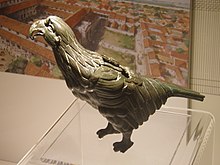Silchester eagle

The Silchester eagle is a Roman bronze casting dating from the first or second century CE, uncovered in the mid 19th century, and subsequently purchased by the Museum of Reading in southern England where it is displayed. The author Rosemary Sutcliff includes the eagle in her 1954 historical novel The Eagle of the Ninth in which she suggests that the artifact was the Roman imperial emblem of the Ninth Legion which disappeared around 120 CE. Subsequent archaeological analysis indicates otherwise, however.
The Silchester eagle was discovered wingless and damaged in either 1866 or 1867 by a Rev. James Joyce during the excavation of a Roman basilica where it was likely part of a larger statue.[1][2] It stands approximately 6 inches (15 cm) high and has a hollow space inside of it which was accessed through a [now missing] square lid located on the top of the back of the bird. It was found buried in a layer of charred wood, leading the discoverer to believe that it might have been the sacred eagle of a Roman legion and been stashed in the rafters of the aerarium.[3]
However, more modern archaeologists have concluded that the piece might have been intended as nothing more than scrap metal by the Romans at the time that it was lost, and was awaiting being recycled when the aerarium burnt down.[4]
References
- ^ Cornell, Tim; Matthews, John (1991). The Roman World. Stonehenge. p. 138. ISBN 978-0867065589.
- ^ "Unknown title". Minerva. 7: 28. 1996.
- ^ Gordon Hills (1873). "Proceedings of the Association: Notes on Roman Eagles". The Journal of the British Archaeological Association. Brit. Arch. Ass.: 183–5.
- ^ Fulford, Michael (1981). "Silchester". Current Archaeology (82): 328.
